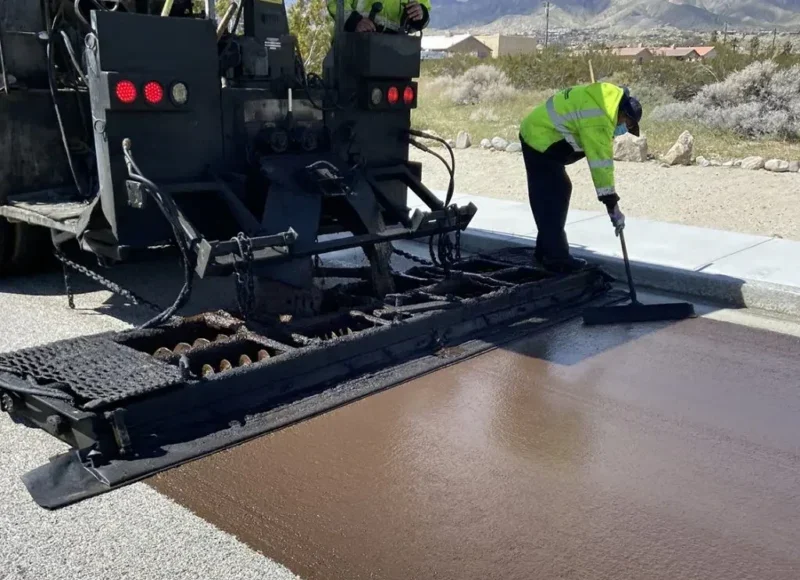🛣️ Bitumen Emulsion: A Versatile Solution for Road Construction
Bitumen emulsion is a mixture of bitumen, water, and emulsifying agents, designed to serve as a binding and waterproofing solution in road construction. Unlike traditional hot-mix bitumen, bitumen emulsion is applied at ambient temperature, making it more environmentally friendly and energy-efficient.
Whether you’re dealing with pothole patching, surface dressing, tack coats, or cold mixes, bitumen emulsion provides a cost-effective and versatile solution suitable for modern pavement technologies.
🧪 What is Bitumen Emulsion?
Bitumen emulsion is produced by dispersing bitumen in water with the help of emulsifiers. The result is a stable suspension that can be sprayed or mixed cold, making it ideal for applications where heating bitumen isn’t practical or safe.
Emulsified bitumens are classified into three types based on ionic charge and setting time:
-
Cationic Emulsion (Most Common)
-
Anionic Emulsion
-
Nonionic Emulsion (Rare)
Definition and Composition of Mixture Bitumen
Bitumen emulsion is a dispersion of small droplets of bitumen in water, stabilized by an emulsifying agent. The emulsion is created by blending bitumen with water and an emulsifier, which helps in forming and maintaining the stability of the emulsion. The emulsifier reduces the surface tension between bitumen and water, allowing them to mix and form a uniform suspension.
📊 Comparison of Bitumen Emulsion Types
| Type | Charge | Application Area | Setting Time |
|---|---|---|---|
| Cationic Emulsion | Positive | Tack coat, cold mix | Rapid, medium, slow |
| Anionic Emulsion | Negative | Surface dressing | Slow |
| Modified Emulsion | Variable | High-performance paving | Customized |
There are three main types of bitumen emulsion, classified based on their breaking mechanism:
⚡ 1. Cationic Bitumen Emulsion:
This is the most widely used type in modern road construction. Cationic emulsions are positively charged, making them suitable for negatively charged mineral aggregates like siliceous stones.
Subtypes Based on Setting Time:
-
RS (Rapid Setting) – Ideal for surface dressing and pothole repair
-
MS (Medium Setting) – Used in cold mix applications
-
SS (Slow Setting) – Suitable for soil stabilization and dense-graded mixes
Example Grades:
-
Cationic RS-1, RS-2
-
Cationic MS
-
Cationic SS-1, SS-2
In cationic emulsions, the emulsifier carries a positive charge. These emulsions are primarily used with aggregates that have a negative charge, such as limestone or granite. Cationic emulsions are more commonly used due to their versatility and ability to work in various weather conditions.
⚡ 2. Anionic Bitumen Emulsion:
Anionic emulsions carry a negative charge, best suited for positively charged aggregates such as limestone. These emulsions are less common today due to compatibility issues with many modern aggregates.
Common Uses:
-
Dust control
-
Low-traffic road surfaces
-
Base stabilization
Example Grades:
-
Anionic SS-1
-
Anionic MS
-
Anionic RS-2
Anionic emulsions have an emulsifier with a negative charge. They are typically used with aggregates that have a positive charge, such as basalt or trap rock. Anionic emulsions are less commonly used but can be advantageous in specific situations.
⚡ 3. Non-Ionic Bitumen Emulsion:
Non-ionic emulsions have an emulsifier with no charge. These emulsions are used when the aggregates have no charge or when there is a need for a stable and slow-breaking emulsion.
🧪 4. Modified Bitumen Emulsion
Modified bitumen emulsions contain polymers or rubber additives, enhancing their elasticity, adhesion, and temperature resistance.
Advantages:
-
Greater durability and crack resistance
-
Improved water resistance
-
Suitable for high-stress pavements, like intersections and heavy traffic roads
Applications:
-
Microsurfacing
-
Chip sealing
-
High-performance surface dressing
🧪 These different types allow engineers to choose the most appropriate emulsion based on aggregate type, project goals, climate, and road usage. Selecting the right bitumen emulsion enhances performance, longevity, and environmental compatibility in road construction.
Advantages of Bitumen Emulsion (Mixture Bitumen)
Emulsified bitumen offers several advantages over traditional hot bitumen in road construction:
Lower Energy Consumption:
The production and application of bitumen emulsion require lower temperatures compared to hot bitumen. This results in reduced energy consumption and greenhouse gas emissions during the manufacturing process.
Improved Workability:
Bitumen emulsion remains in a liquid state at ambient temperatures, making it easier to handle and apply. It can be sprayed or mixed with aggregates directly on-site, allowing for faster construction and reduced labor costs.
Enhanced Mixing and Coating:
Bitumen emulsion provides better coating and adhesion to aggregates, resulting in improved mix design and durability of the asphalt pavement. The emulsion’s small droplet size allows for better coverage and penetration into the pores of the aggregate.
Increased Surface Area:
The emulsification process increases the surface area of bitumen, enhancing its interaction with aggregates and improving the overall performance of the asphalt mixture.
Versatility and Compatibility:
Emulsified bitumen can be used with a wide range of aggregates, including both acidic and basic materials. It is also compatible with various additives, such as polymers or rejuvenators, allowing for customized mix designs to meet specific project requirements.
✅ Benefits of Bitumen Emulsion
-
♻️ Eco-Friendly: Cold application reduces energy usage and emissions
-
🔥 No Need for Heating: Safer and easier to handle on-site
-
🌡️ Weather-Resistant: Can be applied in varying climate conditions
-
🏗️ Versatile: Suitable for multiple roadwork applications
-
💧 Water-Based: Enhances penetration and adhesion
-
🧪 Customizable: Available in different grades and setting times
Applications of Bitumen Emulsion (Mixture Bitumen)
Bitumen emulsion finds extensive applications in road construction and maintenance, including:
Surface Dressing:
Bitumen emulsion is commonly used for surface dressing, where a thin layer of the emulsion is sprayed on the existing road surface followed by the application of aggregate. This process helps in sealing cracks, waterproofing the surface, and restoring skid resistance.
Slurry Seal and Microsurfacing:
Bitumen emulsion is used in slurry seal and microsurfacing applications, where a mixture of the emulsion, aggregate, and additives is applied to the road surface. This improves surface durability, seals cracks, and provides a smooth and safe driving experience.
Cold Mix Asphalt:
Bitumen emulsion is used in the production of cold mix asphalt, which can be stockpiled and used as needed. Cold mix asphalt is ideal for temporary repairs, pothole filling, and remote construction sites where hot mix asphalt is not readily available.
Soil Stabilization:
Bitumen emulsion is used for soil stabilization, where it is mixed with soil to improve its strength, reduce permeability, and prevent erosion. This is particularly beneficial in areas with weak or unstable soils.
Prime Coating:
Bitumen emulsion serves as a prime coat, which is applied to the prepared base of the road before the placement of the asphalt layers. The prime coat improves adhesion between the base and the subsequent layers, enhancing the overall pavement performance.
❓Frequently Asked Questions (FAQ)
1. ❔ What is bitumen emulsion used for?
🛣️ Emulsified bitumen is used in tack coats, prime coats, cold mix asphalts, surface dressing, and pothole repairs.
2. ❔ How is Emulsified bitumen different from regular bitumen?
🌡️ Unlike regular bitumen, emulsified bitumen can be applied cold, making it energy-efficient and easier to use in remote or low-resource settings.
3. ❔ Is Emulsified bitumen suitable for all weather?
✅ Yes, depending on the grade, it can be formulated for rainy, humid, or dry climates, improving road durability in various environments.
4. ❔ How long does bitumen emulsion take to set?
⏱️ Setting time varies based on the emulsion type:
-
Rapid-setting: Minutes
-
Medium-setting: Hours
-
Slow-setting: Longer for mixing with aggregates
5. ❔ Is bitumen emulsion environmentally friendly?
♻️ Yes. Since it uses water as a medium, it reduces emissions, energy use, and environmental risks compared to hot bitumen.
🏁 Conclusion
Bitumen Emulsion (Mixture Bitumen) is a versatile and environmentally friendly solution for road construction and maintenance. It offers advantages such as lower energy consumption, improved workability, enhanced mixing and coating, increased surface area, and compatibility with various aggregates and additives.
Emulsified bitumen (Mixture Bitumen) finds applications in surface dressing, slurry seal, microsurfacing, cold mix asphalt, soil stabilization, and prime coating. The use ofbitumen emulsion in road engineering can result in cost savings, faster construction, and more durable and high-performing road surfaces. As the industry continues to prioritize sustainability and efficiency, bitumen emulsion will continue to play a vital role in the future of road construction.
📣 Call to PARS Universal Bitumen
👉 Looking for High-Quality Bitumen Emulsion?
We in Pars Universal Bitumen, offer a full range of cationic and anionic bitumen emulsions, customized to meet your road construction and maintenance needs.
📞 Get in touch with our technical experts today to select the right grade for your project.
🛒 Browse Emulsion Products Now →Pars Universal Bitumen: Emulsified bitumen Quote
📧 Email: [email protected]
📞 Phone: +971 4 878 2031
🌐 Visit: Pub-ltd
🛒 Order Emulsified Bitumen Today. If You have any other Query or Question you want to ask, Please don’t hesitate to Contact Us.



